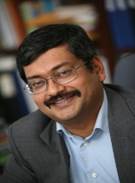Aerosol Science and Engineering Enabling Applications in Energy, Environment, Agriculture and Medicine
Prof. Pratim Biswas
The Lucy and Stanley Lopata Professor & Asst. Vice Chancellor
Dept. of Energy, Environmental and Chemical Engineering
Washington University in St. Louis, St. Louis, MO 63130, USA
Time: June 29 (Friday) 9:30am-11:30am
Location:西安交通大学北二楼(近东南门) 1402会议室
Abstract:maybe problematic and their emissions need to be controlled (6). The intentionally producAerosols, particles that are suspended in a gaseous medium, are ubiquitous and found in nature and engineered systems. They occur in a range of sizes, shapes and compositions and are relevant to important phenomena such as climate change, human health, environmental and energy processes. These particles are both inadvertently and intentionally produced in a variety of systems (1). The inadvertently produced particles ed particles have applications in a variety of fields, and form the backbone of the field of nanotechnology. The presentation will describe an understanding of the formation of these particles in gas-phase processes (2, 3), and report on recent scientific advances. The focus will be on the measurement of the sub-nanometer size particles to highlight the important pathways of early stages of particle formation (2). A description of aerosol science and engineering that enables fundamental studies both mechanistically, and by the availability of well controlled particles to understand property-function relationships will be presented. The second part of the talk will focus on aerosol science and engineering enabling a variety of applications. In air quality studies, the development of low cost PM sensors that operate in a wireless modality will be described. In energy systems, the synthesis of novel light harvesting devices (1) to both produce electricity and promote chemistry (reduction of carbon dioxide) (8) will be discussed. The use of aerosol science principles to guide the synthesis of novel materials with strictly controlled characteristics for cancer treatment will be elucidated (5). Finally, approaches to produce efficient fertilizers that are delivered by innovative aerosol techniques will be described that promote smart agriculture reducing the adverse environmental consequences of excessive fertilizer use (4, 7).
1) Advanced Energy Materials, 7, 1700210, 2017; 2) Proc. Combustion Institute, 36 (1), 745-752, 2017; 3) Progress in Energy and Combustion Science, 55, -59, 2016; 4) Frontiers in Plant Sciences. 7, 1288, 2016; 5) Nanoscale. 8: 12639 – 12647, 2016; 6) Proc. Combustion Institute, 35: 2347-2354, 2, 2015; 7) J of Nanoparticle Research, 15: 1-13, 2013; 8) J Am Chem Soc, 134: 11276-11281, 2012.

Pratim Biswas教授,Journal of Aerosol Science主编,1985年获得加州理工大学博士学位,现任圣路易斯华盛顿大学能源环境和化工系主任,圣路易斯华盛顿大学助理副校长,以及麦道学会国际能源环境合作处主任,曾任美国气溶胶研究协会AAAR主席。
Biswas教授是世界公认的知名气溶胶科学家之一,他先后获得了气溶胶和化工界诸多奖项,包括Kenneth Whitby Award,David Sinclair Award,Lawrence K. Cecil Award等。Biswas教授的研究包含反应器及大气环境下颗粒物形成机理和动力学、颗粒物捕集及特性描述、纳米毒性、先进纳米材料合成、太阳能和能量存储装置设计、生物质燃烧等领域。近些年来,他在火焰合成纳米材料及功能性多孔纳米薄膜方面做出了突出贡献。Biswas教授在Progress in Energy and Combustion Science、Journal of the American Chemical Society、ACS Nano、Combustion and Flame、Proceeding of the Combustion Institute等国际顶级期刊发表论文365篇,他引逾13000次,已培养50余位博士。